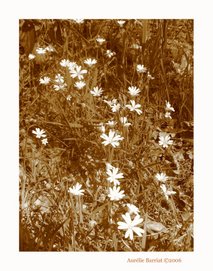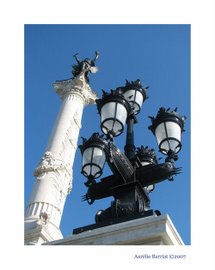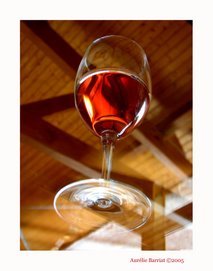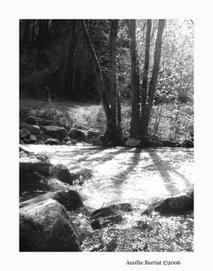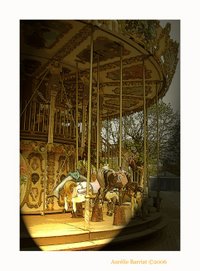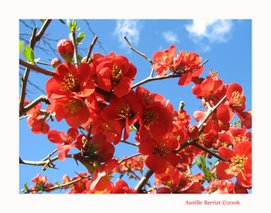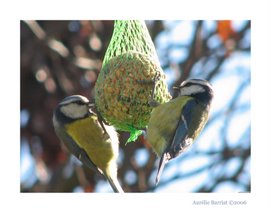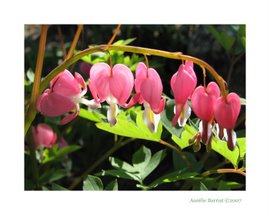Bibliographic description
ROWE, Neil C.; FEW, Brian. Automatic Caption Localization for Photographs on World Wide Web Pages [on line]. Monterey: Department of Computer Science, U. S. Naval Postgraduate School, 1998. Available on: http://www.nps.navy.mil/Content/CS/ncrowe/marie/webpics.html"
Dublin Core
Title : Automatic Caption Localization for Photographs on World Wide Web Pages
Creator : Neil C. Rowe, Brian Frew
Subject : photograph retrieval / Photograph indexing / World Wide Web
Description : "Pictures, especially photographs, are one of the most valuable resources available on the Internet through the popular World Wide Web. Unlike text, most photographs are valuable primary sources of real-world data. Unlike conventional copy technology, photographs on the Web maintain their quality under transmission. Interest has increased recently in multimedia technology as its speed has improved by hardware and software refinements; photographs also benefit from these advances. This has meant that multimedia resources on the Web have grown quickly. For these reasons, indexing and retrieval of photographs is becoming increasingly critical."
Publisher : Department of Computer Science, U. S. Naval Postgraduate School, Monterey
Date : 1998
Type : Article
Format : HTML
Identifier : http://www.nps.navy.mil/Content/CS/ncrowe/marie/webpics.html
Source: http://www.nps.edu/
Language : En
Relation : -
Coverage : USA
Rights : U. S. Naval Postgraduate School
Abstract
"A variety of software tools index text of the World Wide Web, but little attention has been paid to the many photographs. We explore the indirect method of locating for indexing the likely explicit and implicit captions of photographs. We use multimodal clues including the specific words used, the syntax, the surrounding layout of the Web page, and the general appearance of the associated image. Our MARIE-3 system thus avoids full image processing and full natural-language processing, but shows a surprising degree of success. Experiments with a semi-random set of Web pages showed 41% recall with 41% precision for the task of distinguishing captions from other text, and 70% recall with 30% precision. This is much better than chance since actual captions were only 1.4% of the text on pages with photographs."
Monday 16 April 2007
Thursday 29 March 2007
SPIRO: Slide and Photograph, Image Retrieval Online
Bibliographic description
ARCHITECTURE VISUAL RESOURCES LIBRARY. SPIRO [on line]. Berkeley: University of California, 11 december 2006. Available on: http://www.mip.berkeley.edu/query_forms/browse_spiro_form.html
Dublin Core
Title : SPIRO
Creator : Architecture Visual Resources Library, Department of Architecture, College of Environmental Design, University of California, Berkeley
Subject : Image database / architecture / Visual arts / City planning / Urban development
Description : "SPIRO is the visual online public access catalog to the 35mm slide collection of the Architecture Visual Resources Library (AVRL) at the University of California at Berkeley. The collection numbers over 250,000 slides and 20,000 photographs."
Publisher : University of California, Berkeley
Date : 2006-12-11
Type : Image Database
Format : HTML
Identifier : http://www.mip.berkeley.edu/query_forms/browse_spiro_form.html
Source: http://www.arch.ced.berkeley.edu/resources/archslides.htm
Language : En
Relation : http://www.mip.berkeley.edu/spiro/about.html
http://www.berkeley.edu/
Coverage : USA
Rights : Architecture Visual Resources Library
Abstract
"SPIRO permits access to the collection by seven access points which may be used independently or in combination:
historical period
place
personal name
object name
subject terms
source of image
image identification number
As of January 2004, SPIRO contained over 63,000 records linked to images, approximately 20% of AVRL's total slide collection. Thirty-three percent (33%) of the images in SPIRO come from images in books. These are produced in-house by copy stand photography under the fair use and educational copying provisions of the U.S. Copyright Law. Eleven percent (11%) of the images in SPIRO derive from copy stand photography from periodicals, also produced in-house. Thirty-eight percent (38%) of the images are donor- supplied, and eighteen percent (18%) are purchased from commercial slide vendors."
ARCHITECTURE VISUAL RESOURCES LIBRARY. SPIRO [on line]. Berkeley: University of California, 11 december 2006. Available on: http://www.mip.berkeley.edu/query_forms/browse_spiro_form.html
Dublin Core
Title : SPIRO
Creator : Architecture Visual Resources Library, Department of Architecture, College of Environmental Design, University of California, Berkeley
Subject : Image database / architecture / Visual arts / City planning / Urban development
Description : "SPIRO is the visual online public access catalog to the 35mm slide collection of the Architecture Visual Resources Library (AVRL) at the University of California at Berkeley. The collection numbers over 250,000 slides and 20,000 photographs."
Publisher : University of California, Berkeley
Date : 2006-12-11
Type : Image Database
Format : HTML
Identifier : http://www.mip.berkeley.edu/query_forms/browse_spiro_form.html
Source: http://www.arch.ced.berkeley.edu/resources/archslides.htm
Language : En
Relation : http://www.mip.berkeley.edu/spiro/about.html
http://www.berkeley.edu/
Coverage : USA
Rights : Architecture Visual Resources Library
Abstract
"SPIRO permits access to the collection by seven access points which may be used independently or in combination:
historical period
place
personal name
object name
subject terms
source of image
image identification number
As of January 2004, SPIRO contained over 63,000 records linked to images, approximately 20% of AVRL's total slide collection. Thirty-three percent (33%) of the images in SPIRO come from images in books. These are produced in-house by copy stand photography under the fair use and educational copying provisions of the U.S. Copyright Law. Eleven percent (11%) of the images in SPIRO derive from copy stand photography from periodicals, also produced in-house. Thirty-eight percent (38%) of the images are donor- supplied, and eighteen percent (18%) are purchased from commercial slide vendors."
The Subject Analysis of Images: Past, Present and Future
Bibliographic description
WARDEN, Ginger; DUNBAR, Denise; WANCZYCKI, Catherine; O'HANLEY, Suanne. The Subject Analysis of Images: Past, Present and Future [on line]. University of British Columbia School of Library, 27th March 2002. Available on:
http://www.slais.ubc.ca/people/students/student-projects/C_Wanczycki/libr517/homepage.html
Dublin Core
Title : The Subject Analysis of Images: Past, Present and Future
Creator : Ginger Warden, Denise Dunbar, Catherine Wanczycki, Suanne O'Hanley
Subject : image collection / image classification / thesaurus / image indexing
Description : "The Art and Architecture Thesaurus (AAT) is a structured vocabulary that can be used to improve access to art, architecture, and material culture."
Publisher : University of British Columbia School of Library
Date : 2002-03-27
Type : Web site
Format : HTML
Identifier : http://www.slais.ubc.ca/people/students/student-projects/C_Wanczycki/libr517/homepage.html
Source: http://www.slais.ubc.ca/
Language : En
Relation : -
Coverage : UK
Rights : No
Extract
"Image collections exist for many purposes: medicine (ultrasounds, CAT scans), architecture (building plans), geography (aerial photos, maps), art (paintings, cartoons), business (trademarks), history (photographs). Some image collections are very large. The Getty Institute's Photo Study Collection, for example, has over two million photographs. Indexing collections of this size can be extremely time consuming, and unlike text, images cannot be searched by keyword. Many automatic indexing systems have been developed, but what computers can currently extract from images are "mostly low-level features" (Rui, 1999) like color, shape, and texture. Research on the information needs of users, and on human perception of images may, in time, contribute the knowledge needed to produce the most precise and efficient retrieval systems possible.
In the meantime, librarians contending with image collections have to make decisions about how best to provide access to them. Currently, there is no universal consensus in libraries. In a survey of 58 libraries in the U.K., (Graham, 1999) the clear majority of respondents employed in-house methods of classifying and indexing their collections, rather than relying on publicized schemes, such as the AAT (Art and Architecture Thesaurus), LCTGM (Library of Congress Thesaurus for Graphic Materials), and LCSH (Library of Congress Subject Headings). This is likely the result of tradition. Curators of image collections were left to their own devices for most of the century, insofar as subject headings for images went, while LCSH concentrated on primarily text-based materials. Many different thesauri were developed by individuals or groups of individuals to deal with particular collections but efforts to create a universally acceptable indexing language for images has only been a point of interest in the past 30 years or so, with the increasing volume of available images and the desire for increased resource-sharing between institutions.
The AAT and LCTGM are presently the two most widely accepted vocabularies for use with image collections. Their development, structure and scope are the main focus of this website. Subject headings from each are applied to several types of images by way of example. We also look to the past and future of subject access to images by surveying both the methods librarians have used in the past (and are still using today to some extent) and the methods that are currently being developed (and to some extent already in place)."
WARDEN, Ginger; DUNBAR, Denise; WANCZYCKI, Catherine; O'HANLEY, Suanne. The Subject Analysis of Images: Past, Present and Future [on line]. University of British Columbia School of Library, 27th March 2002. Available on:
http://www.slais.ubc.ca/people/students/student-projects/C_Wanczycki/libr517/homepage.html
Dublin Core
Title : The Subject Analysis of Images: Past, Present and Future
Creator : Ginger Warden, Denise Dunbar, Catherine Wanczycki, Suanne O'Hanley
Subject : image collection / image classification / thesaurus / image indexing
Description : "The Art and Architecture Thesaurus (AAT) is a structured vocabulary that can be used to improve access to art, architecture, and material culture."
Publisher : University of British Columbia School of Library
Date : 2002-03-27
Type : Web site
Format : HTML
Identifier : http://www.slais.ubc.ca/people/students/student-projects/C_Wanczycki/libr517/homepage.html
Source: http://www.slais.ubc.ca/
Language : En
Relation : -
Coverage : UK
Rights : No
Extract
"Image collections exist for many purposes: medicine (ultrasounds, CAT scans), architecture (building plans), geography (aerial photos, maps), art (paintings, cartoons), business (trademarks), history (photographs). Some image collections are very large. The Getty Institute's Photo Study Collection, for example, has over two million photographs. Indexing collections of this size can be extremely time consuming, and unlike text, images cannot be searched by keyword. Many automatic indexing systems have been developed, but what computers can currently extract from images are "mostly low-level features" (Rui, 1999) like color, shape, and texture. Research on the information needs of users, and on human perception of images may, in time, contribute the knowledge needed to produce the most precise and efficient retrieval systems possible.
In the meantime, librarians contending with image collections have to make decisions about how best to provide access to them. Currently, there is no universal consensus in libraries. In a survey of 58 libraries in the U.K., (Graham, 1999) the clear majority of respondents employed in-house methods of classifying and indexing their collections, rather than relying on publicized schemes, such as the AAT (Art and Architecture Thesaurus), LCTGM (Library of Congress Thesaurus for Graphic Materials), and LCSH (Library of Congress Subject Headings). This is likely the result of tradition. Curators of image collections were left to their own devices for most of the century, insofar as subject headings for images went, while LCSH concentrated on primarily text-based materials. Many different thesauri were developed by individuals or groups of individuals to deal with particular collections but efforts to create a universally acceptable indexing language for images has only been a point of interest in the past 30 years or so, with the increasing volume of available images and the desire for increased resource-sharing between institutions.
The AAT and LCTGM are presently the two most widely accepted vocabularies for use with image collections. Their development, structure and scope are the main focus of this website. Subject headings from each are applied to several types of images by way of example. We also look to the past and future of subject access to images by surveying both the methods librarians have used in the past (and are still using today to some extent) and the methods that are currently being developed (and to some extent already in place)."
Subscribe to:
Posts (Atom)
